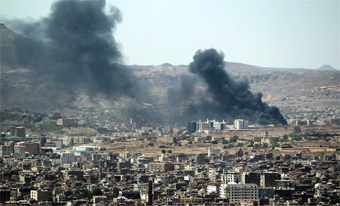
Yemen’s Violence Increases
| published March 30, 2015 |
By Thursday Review staff
Jet fighter planes from several Arab countries struck targets deep inside Yemen on Monday, indicating a major escalation of the conflict in Yemen which is pitting moderate forces against Iranian backed Houthi militants. Saudi Arabia, Yemen’s neighbor to the north, is leading the air attacks on rebel positions. But Saudi Arabia has enlisted the support of other moderate Arab states, including Qatar, Kuwait, and the United Arab Emirates.
The Arab coalition comes only weeks after the United States and other countries evacuated the last of their personnel from embassies and military compounds, and only days after Yemen’s embattled President fled the country by boat. In the ensuing violence, Yemen has descended quickly into civil war, with Iran openly backing and supplying the radical militants.
Yemen’s meltdown comes amidst an increasingly complex Middle East where the interests of some countries in one area may conflict with its interests in another area. The United States has been in high level, tough negotiations with Iran over its development of a nuclear program, and while the U.S. has quietly welcomed the support of Iranian military components in Iraq, where mixed units of Iraqi army, Kurdish fighters and Shiite militants are battling the Islamic State (ISIS), the U.S. does not approve of Iran’s interventions in Yemen, nor its backing of the regime of Bashir al Assad in Syria—a country which is now in its fourth year of civil war.
Overnight, residents and reporters in Yemen’s capital city of Sanaa, witnessed repeated, heavy air attacks. Military analysts and some reporters say that the majority of the attacking planes were Saudi, and most of the targets appeared to be near the Presidential Palace and other key government facilities. There were also reports of air strikes elsewhere in Yemen overnight, including along the coast and in the port city of Aden.
Though Saudi Arabia has mobilized almost all of its ground troops, and has moved much heavy equipment south toward Yemen, on Sunday spokespersons for Saudi Arabia took to western media and the Sunday morning talk shows to assure journalists and foreign policy analysts that the Saudi military has no plans for an outright invasion.
But the specter of a full invasion still concerns many foreign policy experts and military analysts in the U.S. and Europe as Yemen’s civil war increasingly morphs into a proxy war with Iran on one side, and Saudi Arabia and its allies on the other.
Yemen has been a hotbed of militant and extremist activity (including hosting key terror cells) for years, but the moderate government of the now-exiled President Aded Rabbo Mansour Hadi had attempted to keep the militants in check. U.S.-led drone strikes in Yemen had also opened a more-or-less continuous front, an air campaign which targeted hundreds of key terror suspects but also reportedly left civilians dead. Eventually the militant groups forged what became the de facto rebel resistance, and—with the financial and military backing of Iran—gained the upper hand earlier this year. In early March, President Hadi fled the capital and set up a provisional headquarters near the coast. But rebels groups pressed rapidly eastward and south, eventually forcing Hadi and his contingent to flee the country by boat.
Rebel groups have since captured most of the bases once used by the United States and other western powers. The rebels also now control most of the media, including radio and TV.
Saudi Arabia now faces a threat along its southernmost rim as Yemen descends in civil war, and last week it announced that it would form a coalition with several other Arab countries. Its stated goal is to degrade and destroy any potential for terrorism or militant activity in Yemen, but many analysts also believe that Saudi Arabia is engaged in a high stakes struggle with Iran over control of what both countries believe is their sphere of influence.
Meanwhile, the United States, Iran and six other countries are engaged in the last hours of high level talks regarding Iran’s nuclear program. Talks have stalled in the last couple of days, and experts consider it unlikely that a deal acceptable to all parties can be reached. Iran hopes that it can see decades of sanctions finally lifted; the United States, Britain, France, Germany and others want to see Iran’s nuclear ambitions blunted. Some of the stickiest points have come over verification and inspection, as well as the disposition of nuclear materials.
Related Thursday Review articles:
Yemen’s Collapse: Will if Impact Oil Prices?; R. Alan Clanton; Thursday Review; March 27, 2015.
Oil Prices Stumble on Low Storage Capacity; Thursday Review; March 17, 2015.
